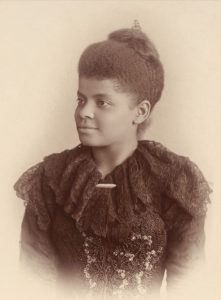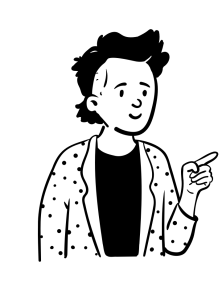4.3 The Public Domain and Why Remixing Matters
Michaela Willi Hooper
The Public Domain: Out of Copyright
Public domain materials come with no copyright restrictions! They include:
- Anything published before 1929 (as of 2024).
- Many things published between 1929 and 1989. Copyright status can be difficult to determine for materials from this time period. See this chart from Cornell for more details.
- Content created by employees of the U.S. federal government and its agencies (CDC, NIH, DOJ, USDA, etc.) in the line of their work. Be cautious when federally funded materials have personal names or other institutions listed as well. These may not be clearly in the public domain. Check with your research support person if you’re not sure.
Using Public Domain Materials Critically and in Context
Just because a work is not copyrighted does not mean it is credible or appropriate. Older works and government publications should include appropriate context, criticism, and commentary. Here are three examples of when you might use public domain materials:
Federal Agency Data
Federal agencies like the FBI and the Census Bureau are often cited as primary sources of criminal justice and demographic statistics. These agencies’ publications, including charts and reports, are in the public domain. But it’s also important to note the limitations of these sources. You might include alternative projects like Mapping Police Violence, as well as critiques of government data, like this article from ProPublica on mislabeling hate crimes.
Images of Historic People and Events
Images created before 1928 are in the public domain. Elizabeth Pearce and student contributors to Contemporary Families remixed two texts in their chapter on “Working Outside of the System: Social Movements and Activism” and included public domain images of key historic people and events, including a portrait of journalist Ida B. Wells (Figure 4.1).

Public Domain Illustrations
In addition to photographs and charts, many projects are also including illustrations. Many illustrators have dedicated their works to the public domain through a CC0 mark, including Pablo Stanley, creator of OpenPeeps. There are no legal restrictions on remixing or creating new works using public domain images. This is an important right for educators, which we’ll discuss in the next section.

Legally, you don’t need to attribute public domain materials, but, of course, attribution or citation is important for other reasons, including:
- Avoiding plagiarism. Even if a creator is no longer living, or is a government employee, giving credit is the right and professional thing to do.
- Being credible. Students are taught to Investigate the Source as part of college information literacy programs. Providing source information, where possible, bolsters your credibility and helps curious readers dive deeper.
- Tracking it down later. Keeping records of your sources also helps you. Sometimes you can use Google’s Reverse Image Search to track down an image source, but not always. It’s also way more time-consuming than attributing sources right away!
We’ll discuss how to attribute public domain materials in more detail in section 4.5, or you can see examples in the Attributions Style Guide.
Anyone can dedicate their work (if they hold the copyright, i.e., didn’t make it for an employer or transfer it to a publisher) to the public domain by applying the CC0 mark. Why would someone want to give their work away for free, without requiring attribution? Because sometimes that’s the most responsible or effective way to share a resource. For example, many researchers put their data in the public domain because data are often not copyrightable, anyway (see box). It can also be cumbersome to attribute when working with massive numbers of data sets. Retaining at least the right to attribution with a Creative Commons Attribution (CC BY) license is more common for authors of books, articles, and images.
What Can Be Copyrighted?
Not everything can be copyrighted. Copyright applies to creative works like books, movies, art, music, and architecture. The telephone book, numerical data (like measurements), and exact copies of public domain works are not creative enough to be copyrighted. Ideas and facts cannot be copyrighted, but the specific way they’re worded or presented (if creative enough) can be. This means:
- You can generally reproduce numerical/statistical data. This also extends to “data gathering and analysis, and to simple, unoriginal methods of presentation and organization” (Jacob et al., 2021). Note that creative elements such as the design or original ways of organizing may be copyrighted. Bonus: A text table is also more accessible to screen readers! If you’re not sure if something you want to use would be copyrighted, talk to your campus copyright expert or your ODC.
- You can paraphrase facts and ideas without copyright restrictions. Remember that plagiarism and copyright violation are different! If someone came up with an idea or conducted a study, citing is still the professional and ethical thing to do.
There are other types of intellectual property besides copyright. These include patents and trademarks, which protect inventions and company brands. Educators and authors primarily deal with copyright. Remember that copyright is automatic, so even if a book, image, or video doesn’t have a © symbol, you can assume it’s copyrighted unless it meets one of the public domain criteria, above.
How Copyright Affects Remixing
The Five Rs
The adaptability and reusability of OER make it so that they are not just free to access, but also free for instructors who want to alter the materials for use in their course. Remember The Hewlett Foundation’s definition of OER: “Teaching, learning and research materials in any medium – digital or otherwise – that reside in the public domain or have been released under an open license that permits no-cost access, use, adaptation and redistribution by others with no or limited restrictions” [emphasis added]. We’ve just discussed the public domain, and the next section will cover open licenses like Creative Commons.
One of the tenets of OER laid out early on in the open education movement was the idea of the 5 Rs (originally the 4 Rs) introduced by David Wiley (2014). These five attributes lay out what it means for something to be truly “open,” as the term is used in open education. The 5 Rs include:
- Retain = the right to make, own, and control copies of the content.
- Reuse = the right to use the content in a wide range of ways
- Revise = the right to adapt, adjust, modify, or alter the content itself
- Remix = the right to combine the original or revised content with other open content to create something new
- Redistribute = the right to share copies of the original content, your revisions, or your remixes with others
Each of these five rights plays an important role in the usefulness of an open educational resource. For example, without the right to remix materials, an instructor would not be able to combine two different OER into a new resource that more closely fits their needs. The right to revise is particularly important from an equity perspective, as discussed in Module 2: Textbook Revision.
Each of the 5 Rs are the exclusive right of the copyright holder unless a work is in the public domain or openly licensed. In the next section, we’ll look at Creative Commons licenses and how they facilitate the expression of the 5 Rs in unique ways. It’s important to understand the different kinds of licenses because not all Creative Commons licenses allow revising and remixing.
Watch the video below (Figure 4.3 – transcript) for a short, clear overview of how copyright and licensing led to the need for open licenses like Creative Commons, which we’ll discuss next.
Self-Check
Test your knowledge of the rights you have with public domain materials compared to All Rights Reserved materials.
Licenses and Attributions
Open Content, Shared Previously
“How Copyright Affects Remixing” is adapted from “Copyright and Open Licensing” by Abbey Elder, The OER Starter Kit, which is licensed under CC BY 4.0. Modifications: Changed structure, expanded, edited, and abridged.
Figure 4.1. “Ida B. Wells Barnett” by Mary Garrity, restored by Adam Cuerden, is in the Public Domain.
Figure 4.2. Image by Pablo Stanley, OpenPeeps, is CC0.
Figure 4.3. “Open Licensing” by Open Oregon Educational Resources is licensed under CC BY 4.0.
Open Content, Original
All other content by Michaela Willi Hooper is licensed under CC BY 4.0.
2/22/25: Updated link to Attribution Style Guide now at Open Oregon FAQs. Changed Figure 4.3 to a different explanation of CC licensing.
Note that I am not an attorney and cannot provide legal advice.
References
Wiley, David. (2014). Defining the ‘open’ in open content and open educational resources. Open Content blog. http://opencontent.org/definition

